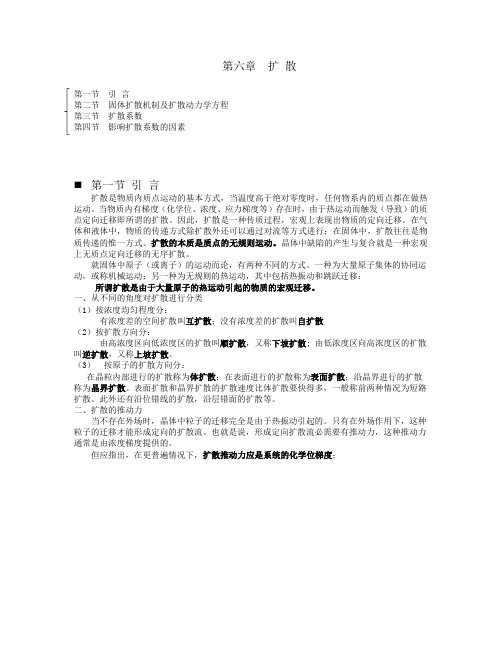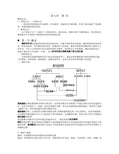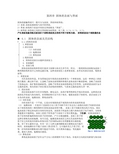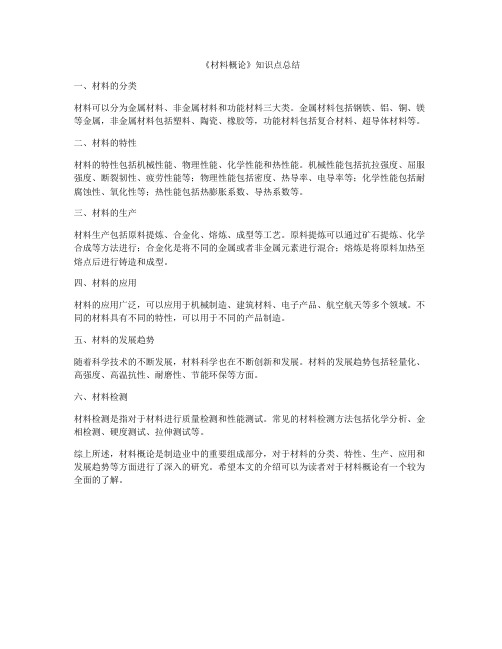武汉理工材料概论重点
材料概论知识点总结

材料概论知识点总结1.材料学纲要结合键离子键、共价键、金属键(化学键)、分子键和氢键1)几种结合键的区别?离子键是以正负离子间的相互作用力形成的结合。
离子键材料由两种以上的电负性相差很大的原子构成。
离子晶体的特性:(1)离子晶体是最密堆积的面心立方或六方密填结构,离子晶体的这种结构特征体现了离子键的各向同性。
(2)对可见光透明,吸收红外波长。
离子震动能级吸收。
共价键不易失去价电子的原子倾向于与邻近原子共有价电子、成为8电子稳定结构。
共价键以拉手结合。
金属键具有方向性,价电子位于共价键附近的几率高于其他处。
共价键形成的条件:原子具有相似的电负性、价电子之和为8。
共价键材料的特性:(1)高硬度、高熔点、导电性差、低膨胀系数,这体现了共价键是强化和键。
(2)性脆,延展性很差,这体现了共价键的方向性。
陶瓷和聚合物;或完全、或部分是共价键。
金属键金属原子失去价电子成为正离子、价电子成为自由电子,离子骨架浸泡在电子的海洋。
本质:是离子、电子间的库仑相互作用。
特性:无方向性,不易被破坏。
使金属具有良好的延展性和导电性,是良好的导体。
分子键由分子之间的作用力(范德华力)而形成的,由于分子键很弱,故结合成的晶体具有低熔点、低沸点、低硬度、易压缩等特性。
氢键氢原子与电负性大的原子X以共价键结合,若与电负性大、半径小的原子Y(O F N等)接近,在X与Y之间以氢去为媒介,生成X-H...Y形式的一种特殊的分子间或分子内相互作用,成为氢键。
1)结合键对材料性能的影响。
金属材料金属材料的结合键主要是金属键。
金属特性:导电性、导热性好;正电阻温度系数;好的延展性;金属光泽等。
陶瓷材料陶瓷材料是包含金属和非金属元素的化合物,其结合键主要是离子键和共价键,大多数是离子键。
离子键赋予陶瓷相当高的稳定性,所以陶瓷材料通常具有极高的熔点和硬度,但同时陶瓷材料的脆性也很大。
高分子材料高分子材料的结合键是共价键、氢键和分子键。
其中,组成分子的结合键是共价键和氢键,而分子间的结合键是范德华键。
武汉理工大学考研材料科学基础重点 第7章-扩散

→
∞
C1 + C2
时,各点浓度都达到 2 ,实现了浓度分布的均匀化。
(3)抛物线扩散规律
浓度C(x,t)与β有一一对应的关系,由于 β = x /(2 Dt ) ,因此C(x,t)与 x / t 之间也存在一一
对应的关系,设K(C)是决定于浓度C的常数,必有 X2=K(C)t
此式称为抛物线扩散规律,其应用范围为不发生相变的扩散。
假设有一单相固溶体,横截面积为A,浓度C不均匀,在dt时间内,
沿x轴方向通过x处截面所迁移的物质的量与处的浓度梯度△C/△x成
正比:
∆m ∝ ∆C A∆t ∆x
dm = −D( ∂C )
即 Adt
∂x
由扩散通量的定义,有
J = −D ∂C ∂x (1)
上式即菲克第一定律 ,式中
J——称为扩散通量,它是单位时间内通过垂直于x轴的单位面积的原子数量,为矢量(因为扩 散流具有方向性),常用单位是g/(cm2.s)或mol/(cm2.s) ;
散偶成分随时间的变化如图5所示,求解菲克第二定律。
C = C1 + C2 − C2 − C1 erf (β )
2
2
式中 erf (β ) 是高斯误差函数。
讨论
(1)上式的用法
① 给定扩散系统,已知扩散时间t,可求出浓度分布曲线
C(x,t)。具体的方法是,查表求出扩散系数D,由D、t以及确定的x,求出 β = x /(2 Dt ) ,查表 求出 erf (β ) ,代入上式求出C(x,t)。
间隙扩散机制适用于间隙型固溶体中间隙原子的扩散。其中,发生间隙扩散的主要(甚至
惟一)是间隙原子,阵点上的原子则可以认为是不动的。C、N、H、B 、O等尺寸较小的间隙原 子在固溶体中的扩散就是按照从一个间隙位置跃迁到其近邻的另一个间隙位置的方式进行的 3. 空位扩散机制
武汉理工大学考研材料科学基础重点 第10章-烧结

第九章烧结烧结定义:1、传统定义:(宏观定义)一种或多种固体粉末经过成型,在加热到一定温度后开始收缩,在低于熔点温度下变成致密、坚硬的烧结体的过程。
2、微观定义:由于固态中分子(或原子)的相互吸引,通过加热,使粉末体产生颗粒粘结,经过物质迁移使粉末产生强度并导致致密化和再结晶的过程。
第一节概述烧结的目的是把粉状材料转变为块体材料,并赋予材料特有的性能。
烧结得到的块体材料是一种多晶材料,其显微结构由晶体、玻璃体和气孔组成。
烧结直接影响显微结构中晶粒尺寸和分布、气孔大小形状和分布及晶界的体积分数等。
从材料动力学角度看,烧结过程的进行,依赖于基本动力学过程—-扩散,因为所有传质过程都依赖于质点的迁移。
一、烧结的定义压制成型后的粉状物料在低于熔点的高温作用下、通过坯体间颗粒相互粘结和物质传递,气孔排除,体积收缩,强度提高、逐渐变成具有一定的几何形状和坚固整个的过程。
二、烧结分类固相烧结是指松散的粉末或经压制具有一定形状的粉末压坯被置于不超过其熔点的设定温度中,在一定的气氛保护下,保温一段时间的操作过程。
所设定的温度称为烧结温度,所用的气氛称为烧结气氛,所用的保温时间称为烧结时间。
液相烧结也是二元系或多元系粉末烧结过程,但烧结温度超过某一组元的熔点,因而形成液相。
活化烧结和液相烧结可以大大提高原子的扩散速率,加速烧结过程,因而出现了把它们统称为强化烧结的趋势。
对松散粉末或粉末压坯同时施以高温和外压,则是所谓的加压烧结。
热压是指对置于限定形状的石墨模具中的松散粉或对粉末压坯加热的同时对其施加单轴压力的烧结过程。
热等静压是指对装于包套之中的松散粉末加热的同时对其施加各向同性的等静压力的烧结过程。
1、烧结与烧成烧结:仅指粉料经加热而致密化的物理过程烧成:包括粉料在加热过程中发生的一切物理和化学变化,例如:气体排除、相变、熔融;氧化、分解、固相反应等2、烧结和熔融烧结是在远低于熔融温度下进行的,至少有一组元处于固态熔融则所有组元转变为液相3、烧结与固相反应固相反应:至少有两个组份参加,产物不同于任一反应物烧结:可单或多组分,不发生化学反应,表面能推动下实现致密化的过程第二节烧结过程及机理一、烧结过程(一)烧结温度对烧结体性质的影响图5是新鲜的电解铜粉(用氢还原的),经高压成型后,在氢气气氛中于不同温度下烧结2小时然后测其宏观性质:密度、比电导、抗拉强度,并对温度作图,以考察温度对烧结进程的影响。
武汉理工大学考研材料科学基础重点 第5章-表面结构与性质

第四章固体的表面与界面固体的接触界面可一般可分为表面、界面和相界面:1)表面:表面是指固体与真空的界面。
2)界面:相邻两个结晶空间的交界面称为“界面”。
3)相界面:相邻相之间的交界面称为相界面。
有三类: S/S;S/V; S/L。
产生表面现象的根本原因在于材料表面质点排列不同于材料内部,材料表面处于高能量状态⏹ 4.1 固体的表面及其结构♦ 4.1.1固体的表面1.理想表面2.清洁表面(1)台阶表面(2)弛豫表面(3)重构表面3.吸附表面4. 固体的表面自由能和表面张力5. 表面偏析6. 表面力场固体表面的结构和性质在很多方面都与体内完全不同。
所以,一般将固体表面称为晶体三维周期结构和真空之间的过渡区域。
这种表面实际上是理想表面,此外还有清洁表面、吸附表面等。
1、理想表面没有杂质的单晶,作为零级近似可将清洁表面理想为一个理想表面。
这是一种理论上的结构完整的二维点阵平面。
它忽略了晶体内部周期性势场在晶体表面中断的影响,忽略了表面原子的热运动、热扩散和热缺陷等,忽略了外界对表面的物理化学作用等。
这种理想表面作为半无限的晶体,体内的原子的位置及其结构的周期性,与原来无限的晶体完全一样。
2、清洁表面清洁表面是指不存在任何吸附、催化反应、杂质扩散等物理化学效应的表面。
这种清洁表面的化学组成与体内相同,但周期结构可以不同于体内。
根据表面原子的排列,清洁表面又可分为台阶表面、弛豫表面、重构表面等。
(1)台阶表面台阶表面不是一个平面,它是由有规则的或不规则的台阶的表面所组成(2)弛豫表面 –在垂直于表面的方向上原子间距不同于该方向上晶格内部原子间距的表面由于固体体相的三维周期性在固体表面处突然中断,表面上原子的配位情况发生变化,相应地表面原子附近的电荷分布将有所改变,表面原子所处的力场与体相内原子也不相同。
为使体系能量尽可能降低,表面上的原子常常会产生相对于正常位置的上、下位移,结果表面相中原子层的间距偏离体相内原子层的间距,产生压缩或膨胀。
武汉理工材料科学基础复习大纲

材料科学基础复习大纲第二章晶体结构2.1 结晶学基础1、概念:晶体晶胞晶胞参数七大晶系晶面指数晶面族晶向指数晶向族2、晶面指数和晶向指数的计算2.2 结合力与结合能按照结合力性质不同分为物理键和化学键化学键包括离子键共价键金属键物理键包括范德华键氢键晶体中离子键共价键比例估算(公式2.16)离子晶体晶格能2.3 堆积(记忆常识)1、最紧密堆积原理及其使用范围:原理略适用范围:典型的离子晶体和金属晶体原因:该原理是建立在质点在电子云分布呈球形对称以及无方向性的基础上的2、两种最紧密堆积方式:面心立方最紧密堆积ABCABC 密排六方最紧密堆积ABABAB系统中:每个球周围有6个八面体空隙 8个四面体空隙N个等径球体做最紧密堆积时系统有2N个四面体空隙N个八面体空隙八面体空隙体积大于四面体空隙3、空间利用率:晶胞中原子体积与晶胞体积的比值(要学会计算)两种最紧密堆积方式的空间利用率为74.05﹪(等径球堆积时)4、影响晶体结构的因素内因:质点相对大小(决定性因素)配位数(概念及计算)极化(概念,极化对晶体结构产生的影响)外因(了解):同质多晶类质多晶同质多晶转变2.4 单质晶体结构(了解)2.5 无机化合物结构(重点每年必考)分析结构从以下几个方面入手:晶胞分子数,何种离子做何种堆积,何种离子添隙,添隙百分比,正负离子配位数,正负离子电价是否饱和,配位多面体,添隙半径的计算(刚好相切时),隙结构与性质的关系。
1、NaCl型:4个NaCl分子 Cl离子做面心立方密堆积,Na离子填充八面体空隙,填充率100﹪,正负离子配位数均为6,电价饱和。
【NaCl6】或【ClNa6】八面体结构与性能:此结构在三维方向上键力均匀,因此无明显解理,破碎后呈颗粒状,粒为多面体形状。
离子键结合,因此有较高的熔点和硬度2、立方ZnS结构:4个ZnS分子S离子做面心立方密堆积,Zn离子填充四面体空隙填充率50﹪,离子配位数均为4,电价饱和,【ZnS4】四面体会画投影图(图2.26)注意:一定要画虚线,一定要标高,一定要有图例(白球黑球代表什么离子)3、萤石(CaF2)结构:(唯一正离子做堆积的结构)4个CaF2分子 Ca离子做面心立方密堆积,F离子填充四面体空隙,填充率100﹪。
武汉理工大学材料概论考试重点

记得把精英资料上的两套题背过1。
0 退火的定义和过程:Annealing, in glassblowing and lampworking, is the process of heating, and then slowly cooling glass to relieve internal stresses热处理退火过程中,退火是消除或减少玻璃的热应力至允许值的热处理过程。
Annealing is to heat treat glass near the softening point to relieve stresses.Then to cool more slowly back through the transition region so as to not reintroduce thermal stresses。
Annealing takes time and temperature:1.Thicker glass anneals more slowly, has larger stresses2。
Thinner glass anneals more quickly, has smaller stresses3.Glass with large thermal expansion requires more annealing2.0 材料的力学性质:Mechanical properties of Materials is the behavior of materials deformed by a set of forces。
Strength强度、硬度 Hardness、韧性 Toughness、2.1 硅酸盐水泥的主要的化学成份:(氧化物成份+矿物成份)There are four major minerals in Portland cement clinker(熟料):C3S—3CaO+SiO2 (硅酸三钙)C2S—2CaO+SiO2 (硅酸二钙)C3A—3CaO+Al2O3(铝酸三钙)C4AF—4CaO+Al2O3+Fe2O3 (铁铝酸四钙)Atten. C = CaO, S = SiO2, A = Al2O3, F = Fe2O32.2 物相的定义:a phase is a state of aggregation of matter that has a distinctive structure。
《材料概论》知识点总结

《材料概论》知识点总结
一、材料的分类
材料可以分为金属材料、非金属材料和功能材料三大类。
金属材料包括钢铁、铝、铜、镁等金属,非金属材料包括塑料、陶瓷、橡胶等,功能材料包括复合材料、超导体材料等。
二、材料的特性
材料的特性包括机械性能、物理性能、化学性能和热性能。
机械性能包括抗拉强度、屈服强度、断裂韧性、疲劳性能等;物理性能包括密度、热导率、电导率等;化学性能包括耐腐蚀性、氧化性等;热性能包括热膨胀系数、导热系数等。
三、材料的生产
材料生产包括原料提炼、合金化、熔炼、成型等工艺。
原料提炼可以通过矿石提炼、化学合成等方法进行;合金化是将不同的金属或者非金属元素进行混合;熔炼是将原料加热至熔点后进行铸造和成型。
四、材料的应用
材料的应用广泛,可以应用于机械制造、建筑材料、电子产品、航空航天等多个领域。
不同的材料具有不同的特性,可以用于不同的产品制造。
五、材料的发展趋势
随着科学技术的不断发展,材料科学也在不断创新和发展。
材料的发展趋势包括轻量化、高强度、高温抗性、耐磨性、节能环保等方面。
六、材料检测
材料检测是指对于材料进行质量检测和性能测试。
常见的材料检测方法包括化学分析、金相检测、硬度测试、拉伸测试等。
综上所述,材料概论是制造业中的重要组成部分,对于材料的分类、特性、生产、应用和发展趋势等方面进行了深入的研究。
希望本文的介绍可以为读者对于材料概论有一个较为全面的了解。
武汉理工大学考研材料科学基础重点 第5章-表面结构与性质

第四章固体的表面与界面固体的接触界面可一般可分为表面、界面和相界面:1)表面:表面是指固体与真空的界面。
2)界面:相邻两个结晶空间的交界面称为“界面”。
3)相界面:相邻相之间的交界面称为相界面。
有三类: S/S;S/V; S/L。
产生表面现象的根本原因在于材料表面质点排列不同于材料内部,材料表面处于高能量状态⏹ 4.1 固体的表面及其结构♦ 4.1.1固体的表面1.理想表面2.清洁表面(1)台阶表面(2)弛豫表面(3)重构表面3.吸附表面4. 固体的表面自由能和表面张力5. 表面偏析6. 表面力场固体表面的结构和性质在很多方面都与体内完全不同。
所以,一般将固体表面称为晶体三维周期结构和真空之间的过渡区域。
这种表面实际上是理想表面,此外还有清洁表面、吸附表面等。
1、理想表面没有杂质的单晶,作为零级近似可将清洁表面理想为一个理想表面。
这是一种理论上的结构完整的二维点阵平面。
它忽略了晶体内部周期性势场在晶体表面中断的影响,忽略了表面原子的热运动、热扩散和热缺陷等,忽略了外界对表面的物理化学作用等。
这种理想表面作为半无限的晶体,体内的原子的位置及其结构的周期性,与原来无限的晶体完全一样。
2、清洁表面清洁表面是指不存在任何吸附、催化反应、杂质扩散等物理化学效应的表面。
这种清洁表面的化学组成与体内相同,但周期结构可以不同于体内。
根据表面原子的排列,清洁表面又可分为台阶表面、弛豫表面、重构表面等。
(1)台阶表面台阶表面不是一个平面,它是由有规则的或不规则的台阶的表面所组成(2)弛豫表面 –在垂直于表面的方向上原子间距不同于该方向上晶格内部原子间距的表面由于固体体相的三维周期性在固体表面处突然中断,表面上原子的配位情况发生变化,相应地表面原子附近的电荷分布将有所改变,表面原子所处的力场与体相内原子也不相同。
为使体系能量尽可能降低,表面上的原子常常会产生相对于正常位置的上、下位移,结果表面相中原子层的间距偏离体相内原子层的间距,产生压缩或膨胀。
- 1、下载文档前请自行甄别文档内容的完整性,平台不提供额外的编辑、内容补充、找答案等附加服务。
- 2、"仅部分预览"的文档,不可在线预览部分如存在完整性等问题,可反馈申请退款(可完整预览的文档不适用该条件!)。
- 3、如文档侵犯您的权益,请联系客服反馈,我们会尽快为您处理(人工客服工作时间:9:00-18:30)。
Definition 材料的定义:The materials making up the surrounding world consist of discrete partic les, having a subm icr oscopic size.Atomic structure and the nature of bonds(原子结构和化学键)—metals and their alloys (metallic bonding 金属键) —organic polymer s 有机聚合物(c ovalent bonding and sec ondary bonding 共价键和二次键)—c er am ic s (ionic bonding and covalent bonding) Mechanical properties:力学性能Which r eflect the behavior of materials, defor med by a set of forc es (概念)Four basic types of stresses : tensile, c ompr essive, shear ,tor sion (拉力,压力,剪切力,扭转力) Physical properties:物理性能the behavior of materials subj ected to the action of temper ature, electric or magnetic fields, or light.电性能Electric properties磁性能Magnetic pr operties热性能Ther mal pr operties光性能Optic al pr opertiesChemical properties:化学性能Which char acterize the behavior of material in a reactive environment. (概念)The four basic aspects of materials scienc e and tec hnology ar e: manufacturing processing, structure,properties and performances结构-性能-工艺之间的关系:First, the processing of a materi al aff ects the structure, second the original structure and properties determine how we can process the material to produce a desired shape一、METAL:(金属)1、金属最显著的特性:good conductors of heat and electricity (热导性,电导性)2、性能:are opaque to visible light; are hard, rigid; can undergo plastic deformation; have a high melting temperature3、金属的晶体点阵:crystal structur e(晶体结构): body-center ed c ubic structur e , fac e-center ed cubic structure , hexagonal close-pac ked structur e(体型、面型,六角形放射状)4、properties of alloys(合金的性能):(more carbon ,more brittle.) have relatively high thermal and electrical conductivities; good energy absorption characteristics ;nonmagnetic properties 5、铸铁概念:c ast iron, essentially an alloy of ir on, carbon and silic on, is c omposed of ir on and fr om2 to 6.67 percent c ar bon, plus manganese, sulfur, and phosphorus, and shaped by being c ast in a mold. 6、The types and properties of cast iron ;white cast iron( hard , brittle ) , gray cast iron (brittle ,withstand large compressive loads but small tensile loads ), alloy cast iron , nodular or ductile cast iron (good castability ,toughness, good wear resistance ,low melting point ,and hardenability ), malleable cast iron (strength ,toughness, ductility ,and machinability)7、carbon steels(碳钢):low carbon steels(含碳0.05~0.32%);medium c ar bon steels(含碳0.35~0.55%);high c ar bon steels(含碳0.60~1.50%)8、不锈钢:ther e are thr ee types of stainless steels: --the martensitic types;the ferritic types ;the austenitic types9、advantages of using Al: one-third of the weight of steel ;good thermal and electrical conductivity ;high strength-to-weight ratio ;can be given a hard surf ace by anodizing and hard coating ;most alloys are weldable ;will not rust ;high ref lectivity ;can be die cast ;easily machined ;good f ormability; nonmagnetic ;nontoxic and one–third of the stif f ness of steel.10、c opper is known for its high ther mal (热导性)and electric al conductivity.11、crystal structure : body-centered cubic structure (barium), face-centered cubic structure (copper),hexagonal close-packed structure (z inc)二、CERA MIC(陶瓷)1、The property of ceramics (陶瓷的性质)Extreme hardness(硬度高) Heat r esistanc e Corrosion r esistanc e Low electrical and ther mal conductivity Low ductility (brittleness)2、Porosity(孔隙度)Open porosity: refer s to the network of por es in a material that is open to the surfac e and into whic h a liquid such as water can penetr ate if the part were submer ged in it。
Closed porosity: refers to those pores that have bec ome sealed within the gr ain structur e 。
Pores affect the strength of ceramics in two ways:(影响强度的毛孔陶瓷两种方式)①、they produc e stress c onc entr ations. Once the str ess r eaches a critic al level, a crac k will for m andpropagate.②、por es r educ e the cross-sectional areas over whicha load c an be applied and,c onsequently, lower the str ess that these materials c an support。
Conventional ceramic processing(传统陶瓷处理);manuf acture of the powder ,its calcinations ,milling ,grading and mixing ,incorporating additives ,shape f orming , drying and densif i cation.三、GLASS(玻璃)1、the measur ed mec hanic al strength of glass is much lower than the theor etical str engthcauses of this loss of str ength :①、the pr esenc e of surfac e defects, suc h as c aused by c hem ic al c orrosion or mec hanic al abr asion。
②、If the glass is cooled too r apidly it does not have time to r elease str esses set up within it during cooling . these ar e "frozen-in" and c an c ause the glass to shatter when it becomes a solid.the transparency is explained by two properties : first ,it has no surface of internal structure which gives reflection or scattering。
